Analysis of Bitcoin: Cryptocurrency Features and Security
VerifiedAdded on 2022/10/04
|13
|3671
|229
Report
AI Summary
This report provides a comprehensive analysis of Bitcoin, a prominent cryptocurrency. It begins with an executive summary and delves into Bitcoin's core concepts, including its operational mechanisms, the technologies that facilitate its functionality such as blockchain and the Lightning Network, and its significance in the financial landscape. The report elucidates Bitcoin's crucial functions, such as enabling a decentralized economy, enhancing transaction security and transparency, facilitating tax-free transactions with reduced fees, and ensuring theft resistance. Furthermore, the report identifies and discusses the challenges associated with Bitcoin, including the high energy and computing resource requirements, potential for wallet loss, and the potential for its misuse in criminal activities. It also addresses various security vulnerabilities, such as wallet vulnerabilities, cybercrime risks, selfish mining, and double-spending issues. The report concludes by presenting security strategies aimed at mitigating these risks, offering a well-rounded understanding of Bitcoin's strengths, weaknesses, and potential within the digital currency ecosystem.

Running head: ANALYSIS OF CRYPTOCURRENCY
ANALYSIS OF CRYPTOCURRENCY
Name of student
Name of university
Author’s note:
ANALYSIS OF CRYPTOCURRENCY
Name of student
Name of university
Author’s note:
Paraphrase This Document
Need a fresh take? Get an instant paraphrase of this document with our AI Paraphraser
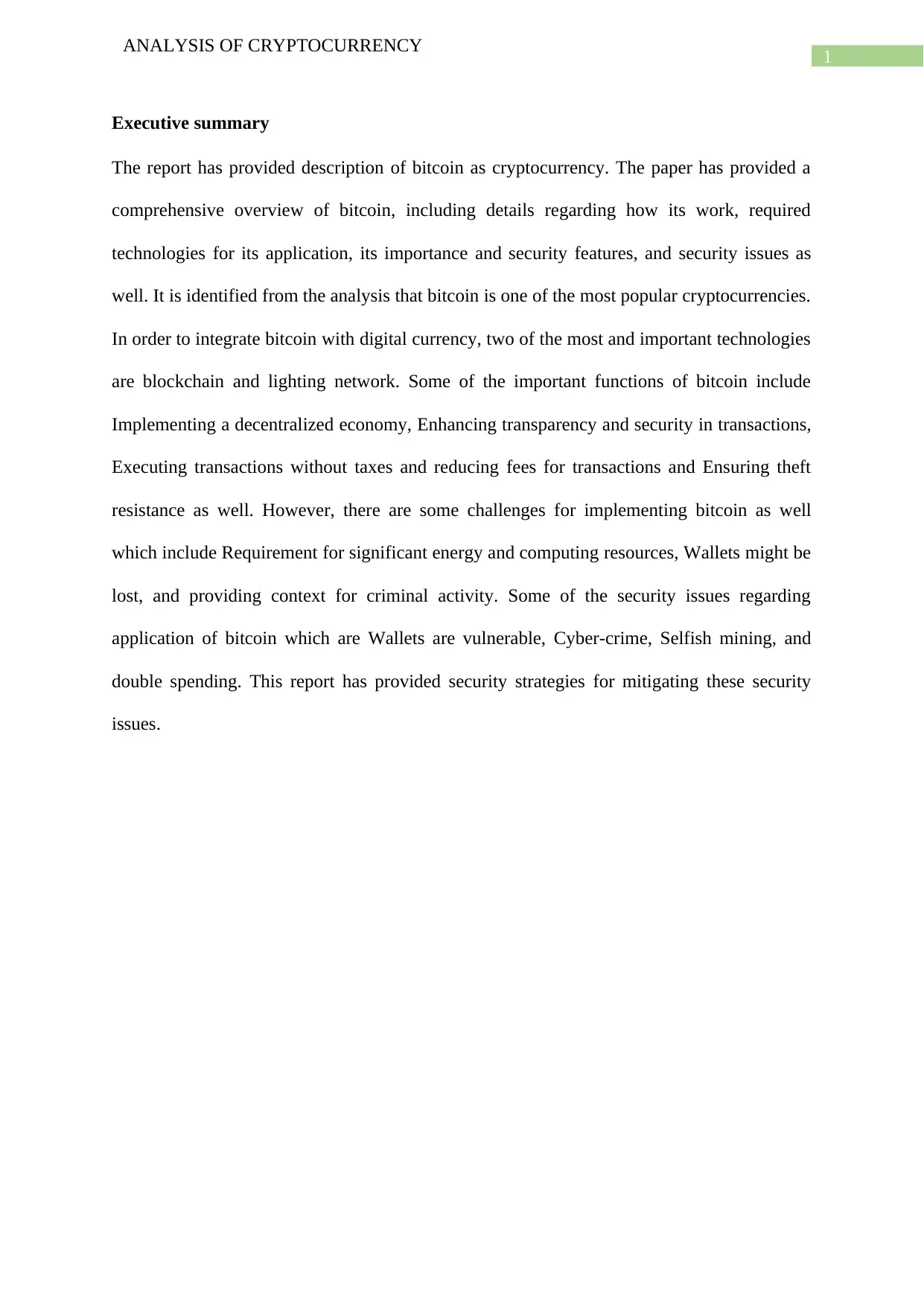
1
ANALYSIS OF CRYPTOCURRENCY
Executive summary
The report has provided description of bitcoin as cryptocurrency. The paper has provided a
comprehensive overview of bitcoin, including details regarding how its work, required
technologies for its application, its importance and security features, and security issues as
well. It is identified from the analysis that bitcoin is one of the most popular cryptocurrencies.
In order to integrate bitcoin with digital currency, two of the most and important technologies
are blockchain and lighting network. Some of the important functions of bitcoin include
Implementing a decentralized economy, Enhancing transparency and security in transactions,
Executing transactions without taxes and reducing fees for transactions and Ensuring theft
resistance as well. However, there are some challenges for implementing bitcoin as well
which include Requirement for significant energy and computing resources, Wallets might be
lost, and providing context for criminal activity. Some of the security issues regarding
application of bitcoin which are Wallets are vulnerable, Cyber-crime, Selfish mining, and
double spending. This report has provided security strategies for mitigating these security
issues.
ANALYSIS OF CRYPTOCURRENCY
Executive summary
The report has provided description of bitcoin as cryptocurrency. The paper has provided a
comprehensive overview of bitcoin, including details regarding how its work, required
technologies for its application, its importance and security features, and security issues as
well. It is identified from the analysis that bitcoin is one of the most popular cryptocurrencies.
In order to integrate bitcoin with digital currency, two of the most and important technologies
are blockchain and lighting network. Some of the important functions of bitcoin include
Implementing a decentralized economy, Enhancing transparency and security in transactions,
Executing transactions without taxes and reducing fees for transactions and Ensuring theft
resistance as well. However, there are some challenges for implementing bitcoin as well
which include Requirement for significant energy and computing resources, Wallets might be
lost, and providing context for criminal activity. Some of the security issues regarding
application of bitcoin which are Wallets are vulnerable, Cyber-crime, Selfish mining, and
double spending. This report has provided security strategies for mitigating these security
issues.
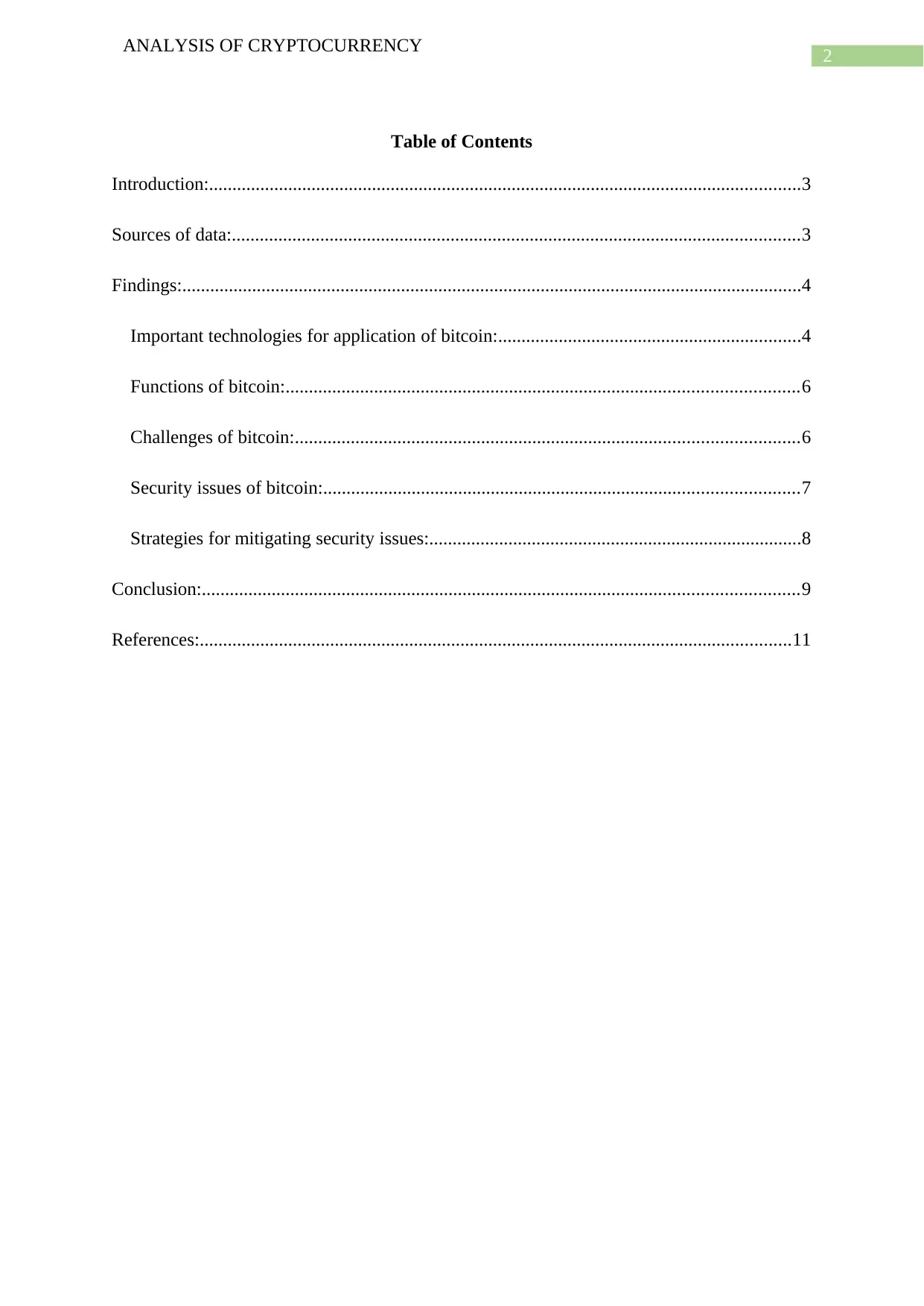
2
ANALYSIS OF CRYPTOCURRENCY
Table of Contents
Introduction:...............................................................................................................................3
Sources of data:..........................................................................................................................3
Findings:.....................................................................................................................................4
Important technologies for application of bitcoin:.................................................................4
Functions of bitcoin:..............................................................................................................6
Challenges of bitcoin:............................................................................................................6
Security issues of bitcoin:......................................................................................................7
Strategies for mitigating security issues:................................................................................8
Conclusion:................................................................................................................................9
References:...............................................................................................................................11
ANALYSIS OF CRYPTOCURRENCY
Table of Contents
Introduction:...............................................................................................................................3
Sources of data:..........................................................................................................................3
Findings:.....................................................................................................................................4
Important technologies for application of bitcoin:.................................................................4
Functions of bitcoin:..............................................................................................................6
Challenges of bitcoin:............................................................................................................6
Security issues of bitcoin:......................................................................................................7
Strategies for mitigating security issues:................................................................................8
Conclusion:................................................................................................................................9
References:...............................................................................................................................11
⊘ This is a preview!⊘
Do you want full access?
Subscribe today to unlock all pages.

Trusted by 1+ million students worldwide
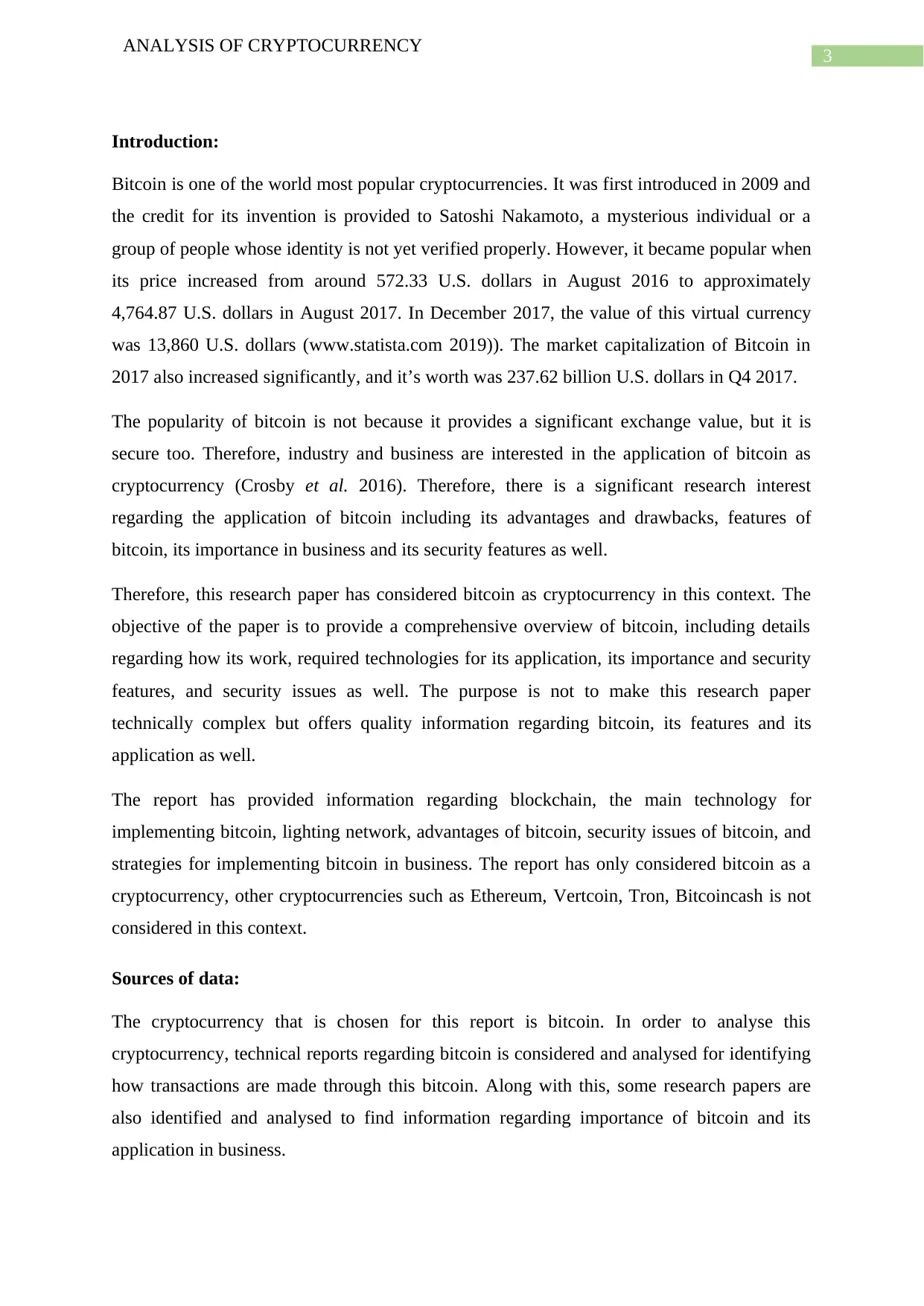
3
ANALYSIS OF CRYPTOCURRENCY
Introduction:
Bitcoin is one of the world most popular cryptocurrencies. It was first introduced in 2009 and
the credit for its invention is provided to Satoshi Nakamoto, a mysterious individual or a
group of people whose identity is not yet verified properly. However, it became popular when
its price increased from around 572.33 U.S. dollars in August 2016 to approximately
4,764.87 U.S. dollars in August 2017. In December 2017, the value of this virtual currency
was 13,860 U.S. dollars (www.statista.com 2019)). The market capitalization of Bitcoin in
2017 also increased significantly, and it’s worth was 237.62 billion U.S. dollars in Q4 2017.
The popularity of bitcoin is not because it provides a significant exchange value, but it is
secure too. Therefore, industry and business are interested in the application of bitcoin as
cryptocurrency (Crosby et al. 2016). Therefore, there is a significant research interest
regarding the application of bitcoin including its advantages and drawbacks, features of
bitcoin, its importance in business and its security features as well.
Therefore, this research paper has considered bitcoin as cryptocurrency in this context. The
objective of the paper is to provide a comprehensive overview of bitcoin, including details
regarding how its work, required technologies for its application, its importance and security
features, and security issues as well. The purpose is not to make this research paper
technically complex but offers quality information regarding bitcoin, its features and its
application as well.
The report has provided information regarding blockchain, the main technology for
implementing bitcoin, lighting network, advantages of bitcoin, security issues of bitcoin, and
strategies for implementing bitcoin in business. The report has only considered bitcoin as a
cryptocurrency, other cryptocurrencies such as Ethereum, Vertcoin, Tron, Bitcoincash is not
considered in this context.
Sources of data:
The cryptocurrency that is chosen for this report is bitcoin. In order to analyse this
cryptocurrency, technical reports regarding bitcoin is considered and analysed for identifying
how transactions are made through this bitcoin. Along with this, some research papers are
also identified and analysed to find information regarding importance of bitcoin and its
application in business.
ANALYSIS OF CRYPTOCURRENCY
Introduction:
Bitcoin is one of the world most popular cryptocurrencies. It was first introduced in 2009 and
the credit for its invention is provided to Satoshi Nakamoto, a mysterious individual or a
group of people whose identity is not yet verified properly. However, it became popular when
its price increased from around 572.33 U.S. dollars in August 2016 to approximately
4,764.87 U.S. dollars in August 2017. In December 2017, the value of this virtual currency
was 13,860 U.S. dollars (www.statista.com 2019)). The market capitalization of Bitcoin in
2017 also increased significantly, and it’s worth was 237.62 billion U.S. dollars in Q4 2017.
The popularity of bitcoin is not because it provides a significant exchange value, but it is
secure too. Therefore, industry and business are interested in the application of bitcoin as
cryptocurrency (Crosby et al. 2016). Therefore, there is a significant research interest
regarding the application of bitcoin including its advantages and drawbacks, features of
bitcoin, its importance in business and its security features as well.
Therefore, this research paper has considered bitcoin as cryptocurrency in this context. The
objective of the paper is to provide a comprehensive overview of bitcoin, including details
regarding how its work, required technologies for its application, its importance and security
features, and security issues as well. The purpose is not to make this research paper
technically complex but offers quality information regarding bitcoin, its features and its
application as well.
The report has provided information regarding blockchain, the main technology for
implementing bitcoin, lighting network, advantages of bitcoin, security issues of bitcoin, and
strategies for implementing bitcoin in business. The report has only considered bitcoin as a
cryptocurrency, other cryptocurrencies such as Ethereum, Vertcoin, Tron, Bitcoincash is not
considered in this context.
Sources of data:
The cryptocurrency that is chosen for this report is bitcoin. In order to analyse this
cryptocurrency, technical reports regarding bitcoin is considered and analysed for identifying
how transactions are made through this bitcoin. Along with this, some research papers are
also identified and analysed to find information regarding importance of bitcoin and its
application in business.
Paraphrase This Document
Need a fresh take? Get an instant paraphrase of this document with our AI Paraphraser
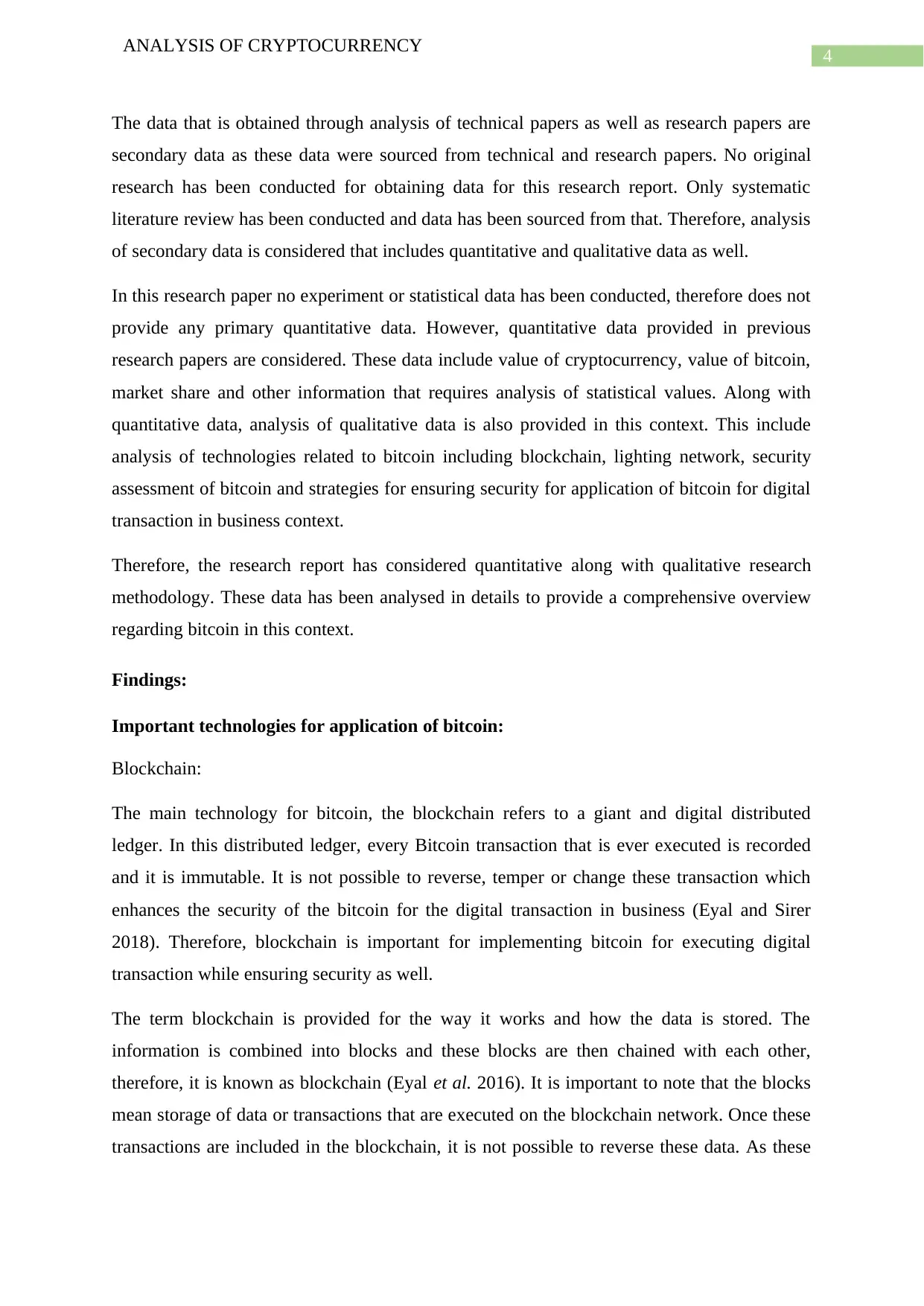
4
ANALYSIS OF CRYPTOCURRENCY
The data that is obtained through analysis of technical papers as well as research papers are
secondary data as these data were sourced from technical and research papers. No original
research has been conducted for obtaining data for this research report. Only systematic
literature review has been conducted and data has been sourced from that. Therefore, analysis
of secondary data is considered that includes quantitative and qualitative data as well.
In this research paper no experiment or statistical data has been conducted, therefore does not
provide any primary quantitative data. However, quantitative data provided in previous
research papers are considered. These data include value of cryptocurrency, value of bitcoin,
market share and other information that requires analysis of statistical values. Along with
quantitative data, analysis of qualitative data is also provided in this context. This include
analysis of technologies related to bitcoin including blockchain, lighting network, security
assessment of bitcoin and strategies for ensuring security for application of bitcoin for digital
transaction in business context.
Therefore, the research report has considered quantitative along with qualitative research
methodology. These data has been analysed in details to provide a comprehensive overview
regarding bitcoin in this context.
Findings:
Important technologies for application of bitcoin:
Blockchain:
The main technology for bitcoin, the blockchain refers to a giant and digital distributed
ledger. In this distributed ledger, every Bitcoin transaction that is ever executed is recorded
and it is immutable. It is not possible to reverse, temper or change these transaction which
enhances the security of the bitcoin for the digital transaction in business (Eyal and Sirer
2018). Therefore, blockchain is important for implementing bitcoin for executing digital
transaction while ensuring security as well.
The term blockchain is provided for the way it works and how the data is stored. The
information is combined into blocks and these blocks are then chained with each other,
therefore, it is known as blockchain (Eyal et al. 2016). It is important to note that the blocks
mean storage of data or transactions that are executed on the blockchain network. Once these
transactions are included in the blockchain, it is not possible to reverse these data. As these
ANALYSIS OF CRYPTOCURRENCY
The data that is obtained through analysis of technical papers as well as research papers are
secondary data as these data were sourced from technical and research papers. No original
research has been conducted for obtaining data for this research report. Only systematic
literature review has been conducted and data has been sourced from that. Therefore, analysis
of secondary data is considered that includes quantitative and qualitative data as well.
In this research paper no experiment or statistical data has been conducted, therefore does not
provide any primary quantitative data. However, quantitative data provided in previous
research papers are considered. These data include value of cryptocurrency, value of bitcoin,
market share and other information that requires analysis of statistical values. Along with
quantitative data, analysis of qualitative data is also provided in this context. This include
analysis of technologies related to bitcoin including blockchain, lighting network, security
assessment of bitcoin and strategies for ensuring security for application of bitcoin for digital
transaction in business context.
Therefore, the research report has considered quantitative along with qualitative research
methodology. These data has been analysed in details to provide a comprehensive overview
regarding bitcoin in this context.
Findings:
Important technologies for application of bitcoin:
Blockchain:
The main technology for bitcoin, the blockchain refers to a giant and digital distributed
ledger. In this distributed ledger, every Bitcoin transaction that is ever executed is recorded
and it is immutable. It is not possible to reverse, temper or change these transaction which
enhances the security of the bitcoin for the digital transaction in business (Eyal and Sirer
2018). Therefore, blockchain is important for implementing bitcoin for executing digital
transaction while ensuring security as well.
The term blockchain is provided for the way it works and how the data is stored. The
information is combined into blocks and these blocks are then chained with each other,
therefore, it is known as blockchain (Eyal et al. 2016). It is important to note that the blocks
mean storage of data or transactions that are executed on the blockchain network. Once these
transactions are included in the blockchain, it is not possible to reverse these data. As these
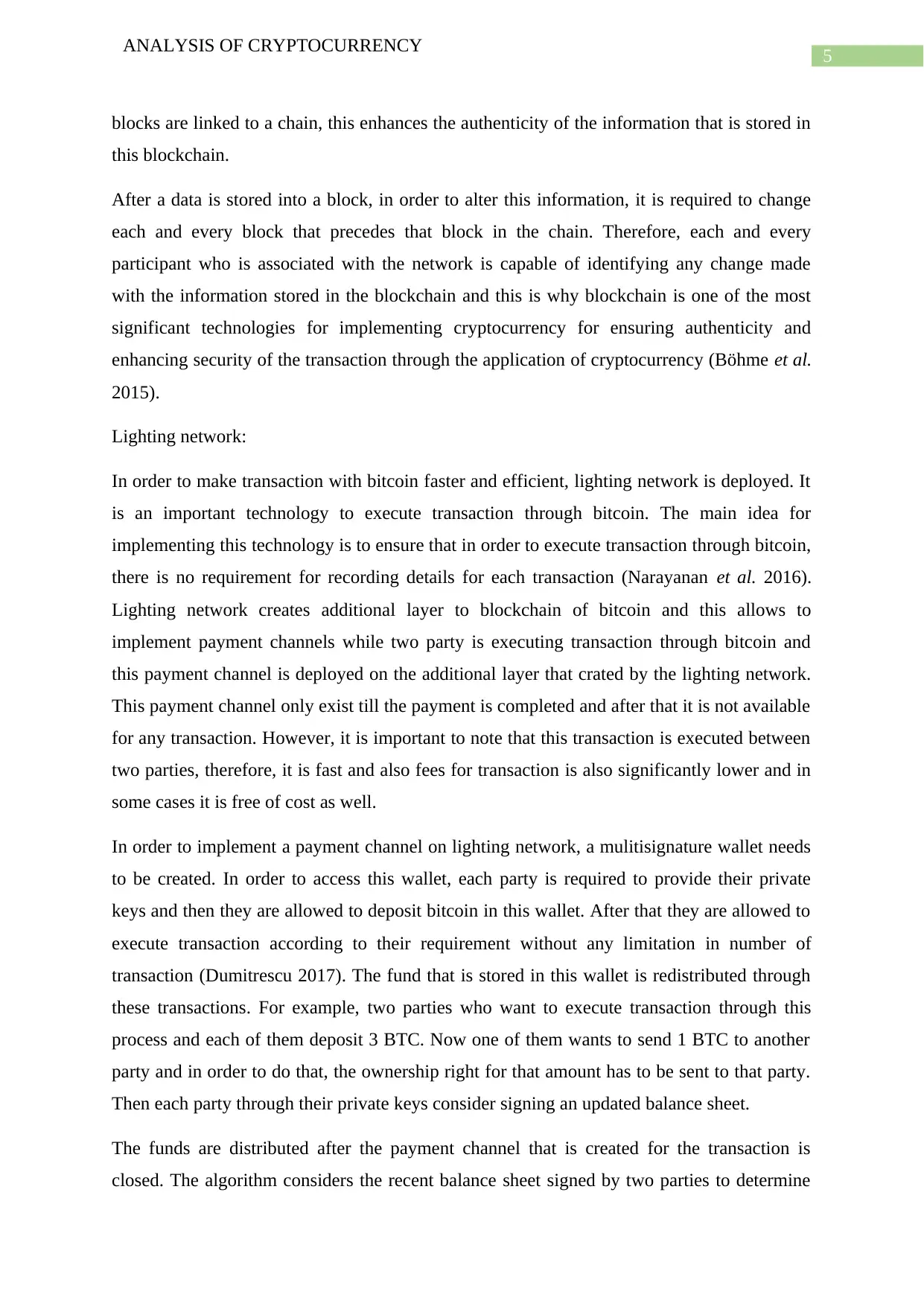
5
ANALYSIS OF CRYPTOCURRENCY
blocks are linked to a chain, this enhances the authenticity of the information that is stored in
this blockchain.
After a data is stored into a block, in order to alter this information, it is required to change
each and every block that precedes that block in the chain. Therefore, each and every
participant who is associated with the network is capable of identifying any change made
with the information stored in the blockchain and this is why blockchain is one of the most
significant technologies for implementing cryptocurrency for ensuring authenticity and
enhancing security of the transaction through the application of cryptocurrency (Böhme et al.
2015).
Lighting network:
In order to make transaction with bitcoin faster and efficient, lighting network is deployed. It
is an important technology to execute transaction through bitcoin. The main idea for
implementing this technology is to ensure that in order to execute transaction through bitcoin,
there is no requirement for recording details for each transaction (Narayanan et al. 2016).
Lighting network creates additional layer to blockchain of bitcoin and this allows to
implement payment channels while two party is executing transaction through bitcoin and
this payment channel is deployed on the additional layer that crated by the lighting network.
This payment channel only exist till the payment is completed and after that it is not available
for any transaction. However, it is important to note that this transaction is executed between
two parties, therefore, it is fast and also fees for transaction is also significantly lower and in
some cases it is free of cost as well.
In order to implement a payment channel on lighting network, a mulitisignature wallet needs
to be created. In order to access this wallet, each party is required to provide their private
keys and then they are allowed to deposit bitcoin in this wallet. After that they are allowed to
execute transaction according to their requirement without any limitation in number of
transaction (Dumitrescu 2017). The fund that is stored in this wallet is redistributed through
these transactions. For example, two parties who want to execute transaction through this
process and each of them deposit 3 BTC. Now one of them wants to send 1 BTC to another
party and in order to do that, the ownership right for that amount has to be sent to that party.
Then each party through their private keys consider signing an updated balance sheet.
The funds are distributed after the payment channel that is created for the transaction is
closed. The algorithm considers the recent balance sheet signed by two parties to determine
ANALYSIS OF CRYPTOCURRENCY
blocks are linked to a chain, this enhances the authenticity of the information that is stored in
this blockchain.
After a data is stored into a block, in order to alter this information, it is required to change
each and every block that precedes that block in the chain. Therefore, each and every
participant who is associated with the network is capable of identifying any change made
with the information stored in the blockchain and this is why blockchain is one of the most
significant technologies for implementing cryptocurrency for ensuring authenticity and
enhancing security of the transaction through the application of cryptocurrency (Böhme et al.
2015).
Lighting network:
In order to make transaction with bitcoin faster and efficient, lighting network is deployed. It
is an important technology to execute transaction through bitcoin. The main idea for
implementing this technology is to ensure that in order to execute transaction through bitcoin,
there is no requirement for recording details for each transaction (Narayanan et al. 2016).
Lighting network creates additional layer to blockchain of bitcoin and this allows to
implement payment channels while two party is executing transaction through bitcoin and
this payment channel is deployed on the additional layer that crated by the lighting network.
This payment channel only exist till the payment is completed and after that it is not available
for any transaction. However, it is important to note that this transaction is executed between
two parties, therefore, it is fast and also fees for transaction is also significantly lower and in
some cases it is free of cost as well.
In order to implement a payment channel on lighting network, a mulitisignature wallet needs
to be created. In order to access this wallet, each party is required to provide their private
keys and then they are allowed to deposit bitcoin in this wallet. After that they are allowed to
execute transaction according to their requirement without any limitation in number of
transaction (Dumitrescu 2017). The fund that is stored in this wallet is redistributed through
these transactions. For example, two parties who want to execute transaction through this
process and each of them deposit 3 BTC. Now one of them wants to send 1 BTC to another
party and in order to do that, the ownership right for that amount has to be sent to that party.
Then each party through their private keys consider signing an updated balance sheet.
The funds are distributed after the payment channel that is created for the transaction is
closed. The algorithm considers the recent balance sheet signed by two parties to determine
⊘ This is a preview!⊘
Do you want full access?
Subscribe today to unlock all pages.

Trusted by 1+ million students worldwide
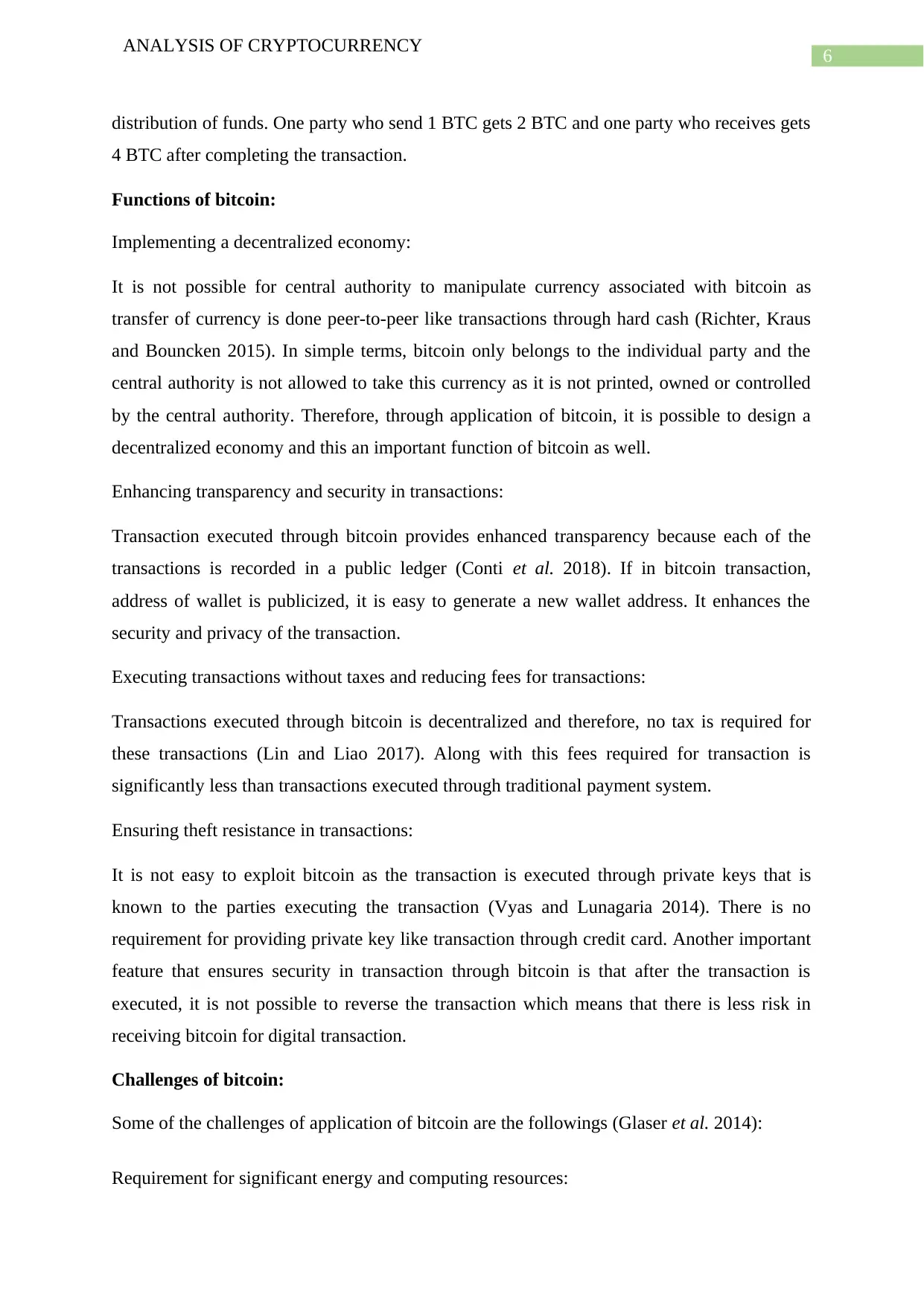
6
ANALYSIS OF CRYPTOCURRENCY
distribution of funds. One party who send 1 BTC gets 2 BTC and one party who receives gets
4 BTC after completing the transaction.
Functions of bitcoin:
Implementing a decentralized economy:
It is not possible for central authority to manipulate currency associated with bitcoin as
transfer of currency is done peer-to-peer like transactions through hard cash (Richter, Kraus
and Bouncken 2015). In simple terms, bitcoin only belongs to the individual party and the
central authority is not allowed to take this currency as it is not printed, owned or controlled
by the central authority. Therefore, through application of bitcoin, it is possible to design a
decentralized economy and this an important function of bitcoin as well.
Enhancing transparency and security in transactions:
Transaction executed through bitcoin provides enhanced transparency because each of the
transactions is recorded in a public ledger (Conti et al. 2018). If in bitcoin transaction,
address of wallet is publicized, it is easy to generate a new wallet address. It enhances the
security and privacy of the transaction.
Executing transactions without taxes and reducing fees for transactions:
Transactions executed through bitcoin is decentralized and therefore, no tax is required for
these transactions (Lin and Liao 2017). Along with this fees required for transaction is
significantly less than transactions executed through traditional payment system.
Ensuring theft resistance in transactions:
It is not easy to exploit bitcoin as the transaction is executed through private keys that is
known to the parties executing the transaction (Vyas and Lunagaria 2014). There is no
requirement for providing private key like transaction through credit card. Another important
feature that ensures security in transaction through bitcoin is that after the transaction is
executed, it is not possible to reverse the transaction which means that there is less risk in
receiving bitcoin for digital transaction.
Challenges of bitcoin:
Some of the challenges of application of bitcoin are the followings (Glaser et al. 2014):
Requirement for significant energy and computing resources:
ANALYSIS OF CRYPTOCURRENCY
distribution of funds. One party who send 1 BTC gets 2 BTC and one party who receives gets
4 BTC after completing the transaction.
Functions of bitcoin:
Implementing a decentralized economy:
It is not possible for central authority to manipulate currency associated with bitcoin as
transfer of currency is done peer-to-peer like transactions through hard cash (Richter, Kraus
and Bouncken 2015). In simple terms, bitcoin only belongs to the individual party and the
central authority is not allowed to take this currency as it is not printed, owned or controlled
by the central authority. Therefore, through application of bitcoin, it is possible to design a
decentralized economy and this an important function of bitcoin as well.
Enhancing transparency and security in transactions:
Transaction executed through bitcoin provides enhanced transparency because each of the
transactions is recorded in a public ledger (Conti et al. 2018). If in bitcoin transaction,
address of wallet is publicized, it is easy to generate a new wallet address. It enhances the
security and privacy of the transaction.
Executing transactions without taxes and reducing fees for transactions:
Transactions executed through bitcoin is decentralized and therefore, no tax is required for
these transactions (Lin and Liao 2017). Along with this fees required for transaction is
significantly less than transactions executed through traditional payment system.
Ensuring theft resistance in transactions:
It is not easy to exploit bitcoin as the transaction is executed through private keys that is
known to the parties executing the transaction (Vyas and Lunagaria 2014). There is no
requirement for providing private key like transaction through credit card. Another important
feature that ensures security in transaction through bitcoin is that after the transaction is
executed, it is not possible to reverse the transaction which means that there is less risk in
receiving bitcoin for digital transaction.
Challenges of bitcoin:
Some of the challenges of application of bitcoin are the followings (Glaser et al. 2014):
Requirement for significant energy and computing resources:
Paraphrase This Document
Need a fresh take? Get an instant paraphrase of this document with our AI Paraphraser
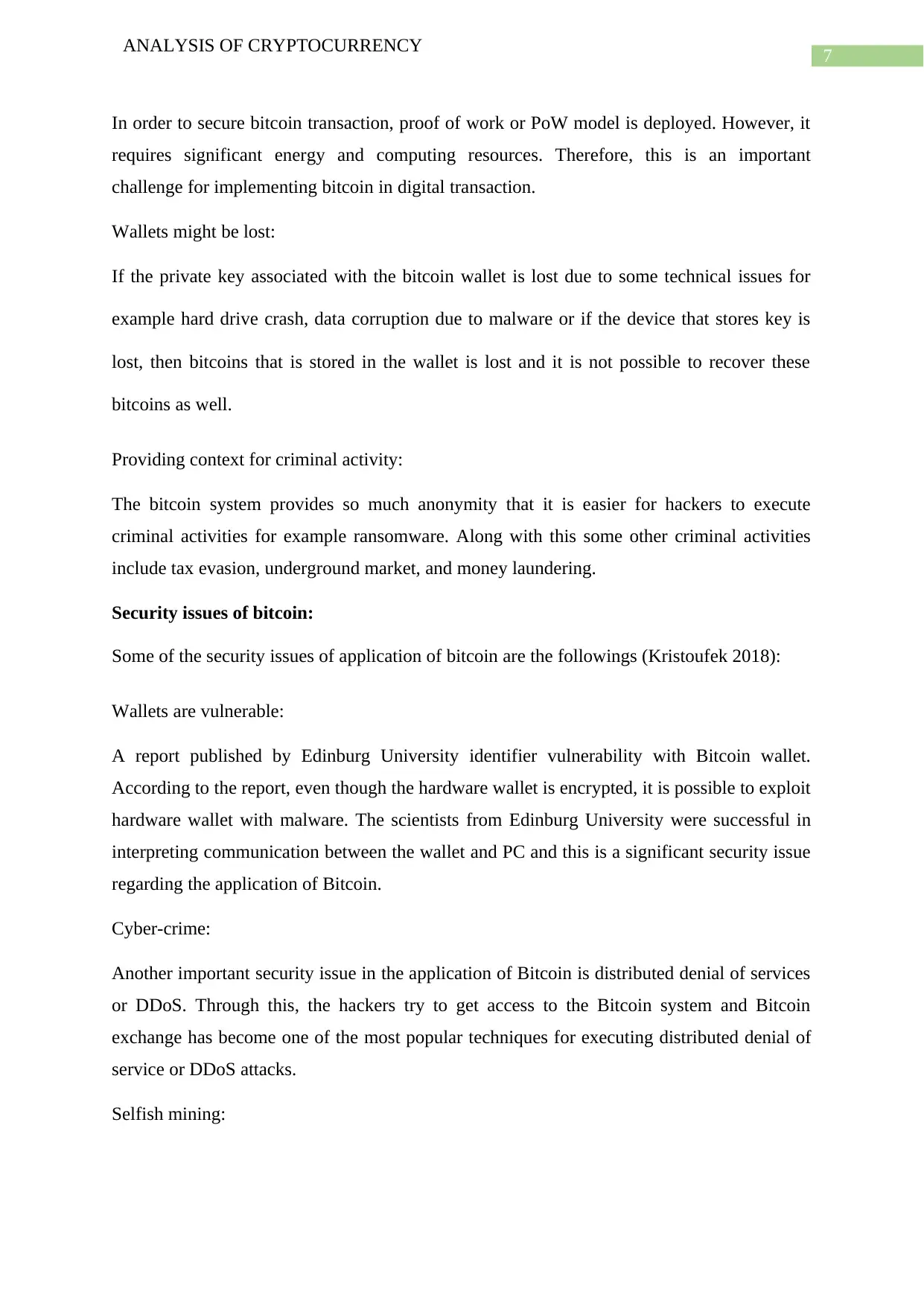
7
ANALYSIS OF CRYPTOCURRENCY
In order to secure bitcoin transaction, proof of work or PoW model is deployed. However, it
requires significant energy and computing resources. Therefore, this is an important
challenge for implementing bitcoin in digital transaction.
Wallets might be lost:
If the private key associated with the bitcoin wallet is lost due to some technical issues for
example hard drive crash, data corruption due to malware or if the device that stores key is
lost, then bitcoins that is stored in the wallet is lost and it is not possible to recover these
bitcoins as well.
Providing context for criminal activity:
The bitcoin system provides so much anonymity that it is easier for hackers to execute
criminal activities for example ransomware. Along with this some other criminal activities
include tax evasion, underground market, and money laundering.
Security issues of bitcoin:
Some of the security issues of application of bitcoin are the followings (Kristoufek 2018):
Wallets are vulnerable:
A report published by Edinburg University identifier vulnerability with Bitcoin wallet.
According to the report, even though the hardware wallet is encrypted, it is possible to exploit
hardware wallet with malware. The scientists from Edinburg University were successful in
interpreting communication between the wallet and PC and this is a significant security issue
regarding the application of Bitcoin.
Cyber-crime:
Another important security issue in the application of Bitcoin is distributed denial of services
or DDoS. Through this, the hackers try to get access to the Bitcoin system and Bitcoin
exchange has become one of the most popular techniques for executing distributed denial of
service or DDoS attacks.
Selfish mining:
ANALYSIS OF CRYPTOCURRENCY
In order to secure bitcoin transaction, proof of work or PoW model is deployed. However, it
requires significant energy and computing resources. Therefore, this is an important
challenge for implementing bitcoin in digital transaction.
Wallets might be lost:
If the private key associated with the bitcoin wallet is lost due to some technical issues for
example hard drive crash, data corruption due to malware or if the device that stores key is
lost, then bitcoins that is stored in the wallet is lost and it is not possible to recover these
bitcoins as well.
Providing context for criminal activity:
The bitcoin system provides so much anonymity that it is easier for hackers to execute
criminal activities for example ransomware. Along with this some other criminal activities
include tax evasion, underground market, and money laundering.
Security issues of bitcoin:
Some of the security issues of application of bitcoin are the followings (Kristoufek 2018):
Wallets are vulnerable:
A report published by Edinburg University identifier vulnerability with Bitcoin wallet.
According to the report, even though the hardware wallet is encrypted, it is possible to exploit
hardware wallet with malware. The scientists from Edinburg University were successful in
interpreting communication between the wallet and PC and this is a significant security issue
regarding the application of Bitcoin.
Cyber-crime:
Another important security issue in the application of Bitcoin is distributed denial of services
or DDoS. Through this, the hackers try to get access to the Bitcoin system and Bitcoin
exchange has become one of the most popular techniques for executing distributed denial of
service or DDoS attacks.
Selfish mining:
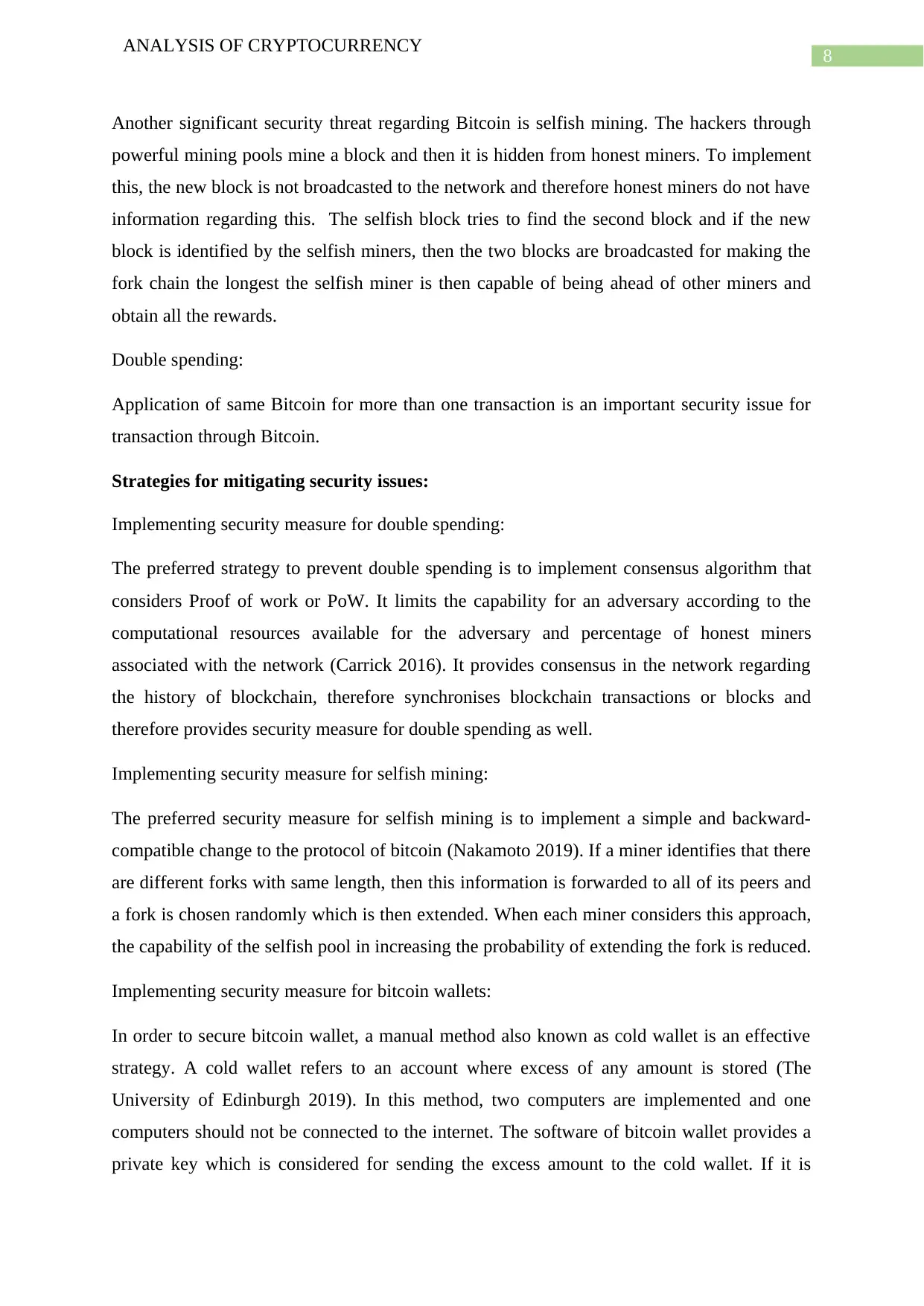
8
ANALYSIS OF CRYPTOCURRENCY
Another significant security threat regarding Bitcoin is selfish mining. The hackers through
powerful mining pools mine a block and then it is hidden from honest miners. To implement
this, the new block is not broadcasted to the network and therefore honest miners do not have
information regarding this. The selfish block tries to find the second block and if the new
block is identified by the selfish miners, then the two blocks are broadcasted for making the
fork chain the longest the selfish miner is then capable of being ahead of other miners and
obtain all the rewards.
Double spending:
Application of same Bitcoin for more than one transaction is an important security issue for
transaction through Bitcoin.
Strategies for mitigating security issues:
Implementing security measure for double spending:
The preferred strategy to prevent double spending is to implement consensus algorithm that
considers Proof of work or PoW. It limits the capability for an adversary according to the
computational resources available for the adversary and percentage of honest miners
associated with the network (Carrick 2016). It provides consensus in the network regarding
the history of blockchain, therefore synchronises blockchain transactions or blocks and
therefore provides security measure for double spending as well.
Implementing security measure for selfish mining:
The preferred security measure for selfish mining is to implement a simple and backward-
compatible change to the protocol of bitcoin (Nakamoto 2019). If a miner identifies that there
are different forks with same length, then this information is forwarded to all of its peers and
a fork is chosen randomly which is then extended. When each miner considers this approach,
the capability of the selfish pool in increasing the probability of extending the fork is reduced.
Implementing security measure for bitcoin wallets:
In order to secure bitcoin wallet, a manual method also known as cold wallet is an effective
strategy. A cold wallet refers to an account where excess of any amount is stored (The
University of Edinburgh 2019). In this method, two computers are implemented and one
computers should not be connected to the internet. The software of bitcoin wallet provides a
private key which is considered for sending the excess amount to the cold wallet. If it is
ANALYSIS OF CRYPTOCURRENCY
Another significant security threat regarding Bitcoin is selfish mining. The hackers through
powerful mining pools mine a block and then it is hidden from honest miners. To implement
this, the new block is not broadcasted to the network and therefore honest miners do not have
information regarding this. The selfish block tries to find the second block and if the new
block is identified by the selfish miners, then the two blocks are broadcasted for making the
fork chain the longest the selfish miner is then capable of being ahead of other miners and
obtain all the rewards.
Double spending:
Application of same Bitcoin for more than one transaction is an important security issue for
transaction through Bitcoin.
Strategies for mitigating security issues:
Implementing security measure for double spending:
The preferred strategy to prevent double spending is to implement consensus algorithm that
considers Proof of work or PoW. It limits the capability for an adversary according to the
computational resources available for the adversary and percentage of honest miners
associated with the network (Carrick 2016). It provides consensus in the network regarding
the history of blockchain, therefore synchronises blockchain transactions or blocks and
therefore provides security measure for double spending as well.
Implementing security measure for selfish mining:
The preferred security measure for selfish mining is to implement a simple and backward-
compatible change to the protocol of bitcoin (Nakamoto 2019). If a miner identifies that there
are different forks with same length, then this information is forwarded to all of its peers and
a fork is chosen randomly which is then extended. When each miner considers this approach,
the capability of the selfish pool in increasing the probability of extending the fork is reduced.
Implementing security measure for bitcoin wallets:
In order to secure bitcoin wallet, a manual method also known as cold wallet is an effective
strategy. A cold wallet refers to an account where excess of any amount is stored (The
University of Edinburgh 2019). In this method, two computers are implemented and one
computers should not be connected to the internet. The software of bitcoin wallet provides a
private key which is considered for sending the excess amount to the cold wallet. If it is
⊘ This is a preview!⊘
Do you want full access?
Subscribe today to unlock all pages.

Trusted by 1+ million students worldwide
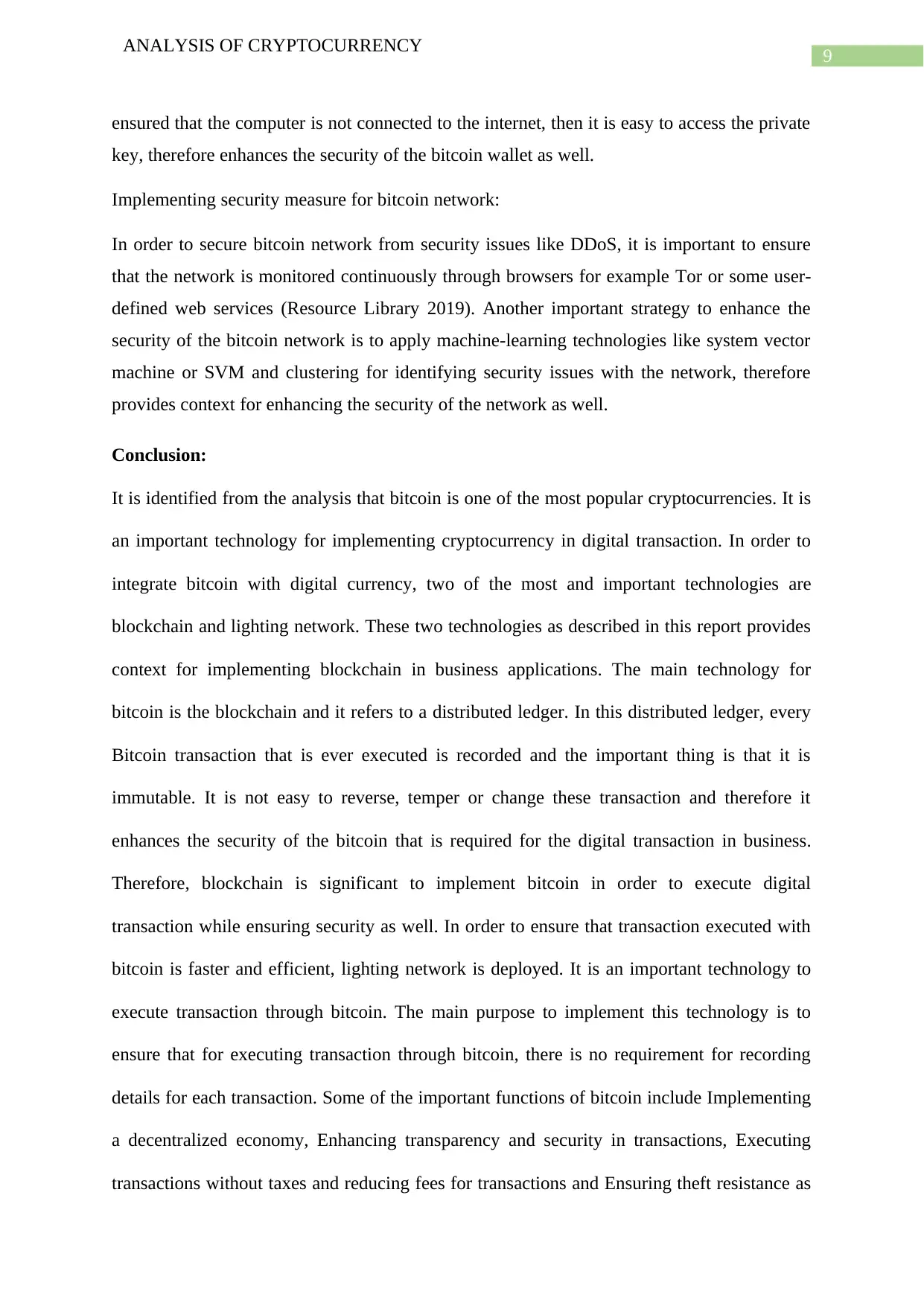
9
ANALYSIS OF CRYPTOCURRENCY
ensured that the computer is not connected to the internet, then it is easy to access the private
key, therefore enhances the security of the bitcoin wallet as well.
Implementing security measure for bitcoin network:
In order to secure bitcoin network from security issues like DDoS, it is important to ensure
that the network is monitored continuously through browsers for example Tor or some user-
defined web services (Resource Library 2019). Another important strategy to enhance the
security of the bitcoin network is to apply machine-learning technologies like system vector
machine or SVM and clustering for identifying security issues with the network, therefore
provides context for enhancing the security of the network as well.
Conclusion:
It is identified from the analysis that bitcoin is one of the most popular cryptocurrencies. It is
an important technology for implementing cryptocurrency in digital transaction. In order to
integrate bitcoin with digital currency, two of the most and important technologies are
blockchain and lighting network. These two technologies as described in this report provides
context for implementing blockchain in business applications. The main technology for
bitcoin is the blockchain and it refers to a distributed ledger. In this distributed ledger, every
Bitcoin transaction that is ever executed is recorded and the important thing is that it is
immutable. It is not easy to reverse, temper or change these transaction and therefore it
enhances the security of the bitcoin that is required for the digital transaction in business.
Therefore, blockchain is significant to implement bitcoin in order to execute digital
transaction while ensuring security as well. In order to ensure that transaction executed with
bitcoin is faster and efficient, lighting network is deployed. It is an important technology to
execute transaction through bitcoin. The main purpose to implement this technology is to
ensure that for executing transaction through bitcoin, there is no requirement for recording
details for each transaction. Some of the important functions of bitcoin include Implementing
a decentralized economy, Enhancing transparency and security in transactions, Executing
transactions without taxes and reducing fees for transactions and Ensuring theft resistance as
ANALYSIS OF CRYPTOCURRENCY
ensured that the computer is not connected to the internet, then it is easy to access the private
key, therefore enhances the security of the bitcoin wallet as well.
Implementing security measure for bitcoin network:
In order to secure bitcoin network from security issues like DDoS, it is important to ensure
that the network is monitored continuously through browsers for example Tor or some user-
defined web services (Resource Library 2019). Another important strategy to enhance the
security of the bitcoin network is to apply machine-learning technologies like system vector
machine or SVM and clustering for identifying security issues with the network, therefore
provides context for enhancing the security of the network as well.
Conclusion:
It is identified from the analysis that bitcoin is one of the most popular cryptocurrencies. It is
an important technology for implementing cryptocurrency in digital transaction. In order to
integrate bitcoin with digital currency, two of the most and important technologies are
blockchain and lighting network. These two technologies as described in this report provides
context for implementing blockchain in business applications. The main technology for
bitcoin is the blockchain and it refers to a distributed ledger. In this distributed ledger, every
Bitcoin transaction that is ever executed is recorded and the important thing is that it is
immutable. It is not easy to reverse, temper or change these transaction and therefore it
enhances the security of the bitcoin that is required for the digital transaction in business.
Therefore, blockchain is significant to implement bitcoin in order to execute digital
transaction while ensuring security as well. In order to ensure that transaction executed with
bitcoin is faster and efficient, lighting network is deployed. It is an important technology to
execute transaction through bitcoin. The main purpose to implement this technology is to
ensure that for executing transaction through bitcoin, there is no requirement for recording
details for each transaction. Some of the important functions of bitcoin include Implementing
a decentralized economy, Enhancing transparency and security in transactions, Executing
transactions without taxes and reducing fees for transactions and Ensuring theft resistance as
Paraphrase This Document
Need a fresh take? Get an instant paraphrase of this document with our AI Paraphraser
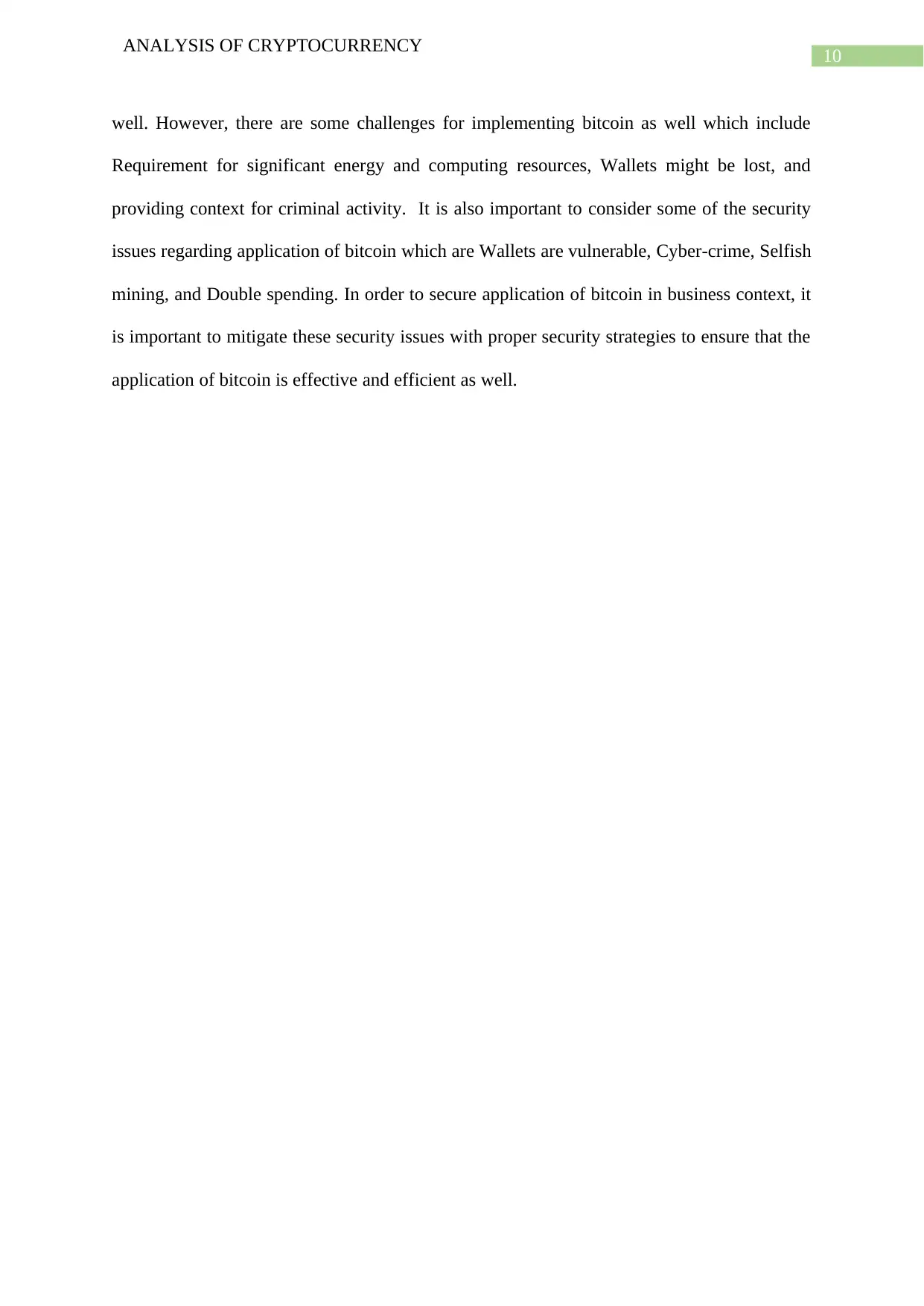
10
ANALYSIS OF CRYPTOCURRENCY
well. However, there are some challenges for implementing bitcoin as well which include
Requirement for significant energy and computing resources, Wallets might be lost, and
providing context for criminal activity. It is also important to consider some of the security
issues regarding application of bitcoin which are Wallets are vulnerable, Cyber-crime, Selfish
mining, and Double spending. In order to secure application of bitcoin in business context, it
is important to mitigate these security issues with proper security strategies to ensure that the
application of bitcoin is effective and efficient as well.
ANALYSIS OF CRYPTOCURRENCY
well. However, there are some challenges for implementing bitcoin as well which include
Requirement for significant energy and computing resources, Wallets might be lost, and
providing context for criminal activity. It is also important to consider some of the security
issues regarding application of bitcoin which are Wallets are vulnerable, Cyber-crime, Selfish
mining, and Double spending. In order to secure application of bitcoin in business context, it
is important to mitigate these security issues with proper security strategies to ensure that the
application of bitcoin is effective and efficient as well.
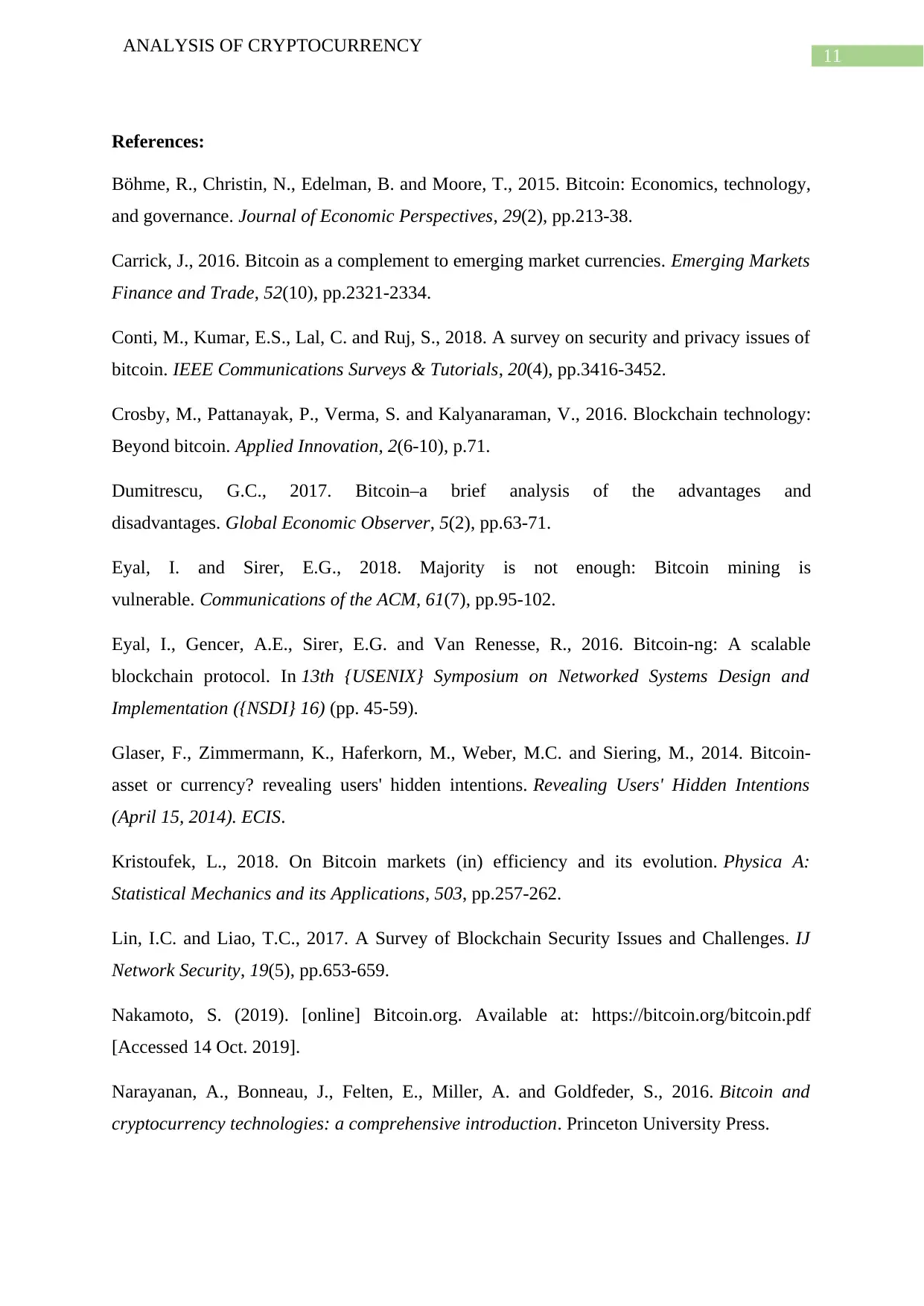
11
ANALYSIS OF CRYPTOCURRENCY
References:
Böhme, R., Christin, N., Edelman, B. and Moore, T., 2015. Bitcoin: Economics, technology,
and governance. Journal of Economic Perspectives, 29(2), pp.213-38.
Carrick, J., 2016. Bitcoin as a complement to emerging market currencies. Emerging Markets
Finance and Trade, 52(10), pp.2321-2334.
Conti, M., Kumar, E.S., Lal, C. and Ruj, S., 2018. A survey on security and privacy issues of
bitcoin. IEEE Communications Surveys & Tutorials, 20(4), pp.3416-3452.
Crosby, M., Pattanayak, P., Verma, S. and Kalyanaraman, V., 2016. Blockchain technology:
Beyond bitcoin. Applied Innovation, 2(6-10), p.71.
Dumitrescu, G.C., 2017. Bitcoin–a brief analysis of the advantages and
disadvantages. Global Economic Observer, 5(2), pp.63-71.
Eyal, I. and Sirer, E.G., 2018. Majority is not enough: Bitcoin mining is
vulnerable. Communications of the ACM, 61(7), pp.95-102.
Eyal, I., Gencer, A.E., Sirer, E.G. and Van Renesse, R., 2016. Bitcoin-ng: A scalable
blockchain protocol. In 13th {USENIX} Symposium on Networked Systems Design and
Implementation ({NSDI} 16) (pp. 45-59).
Glaser, F., Zimmermann, K., Haferkorn, M., Weber, M.C. and Siering, M., 2014. Bitcoin-
asset or currency? revealing users' hidden intentions. Revealing Users' Hidden Intentions
(April 15, 2014). ECIS.
Kristoufek, L., 2018. On Bitcoin markets (in) efficiency and its evolution. Physica A:
Statistical Mechanics and its Applications, 503, pp.257-262.
Lin, I.C. and Liao, T.C., 2017. A Survey of Blockchain Security Issues and Challenges. IJ
Network Security, 19(5), pp.653-659.
Nakamoto, S. (2019). [online] Bitcoin.org. Available at: https://bitcoin.org/bitcoin.pdf
[Accessed 14 Oct. 2019].
Narayanan, A., Bonneau, J., Felten, E., Miller, A. and Goldfeder, S., 2016. Bitcoin and
cryptocurrency technologies: a comprehensive introduction. Princeton University Press.
ANALYSIS OF CRYPTOCURRENCY
References:
Böhme, R., Christin, N., Edelman, B. and Moore, T., 2015. Bitcoin: Economics, technology,
and governance. Journal of Economic Perspectives, 29(2), pp.213-38.
Carrick, J., 2016. Bitcoin as a complement to emerging market currencies. Emerging Markets
Finance and Trade, 52(10), pp.2321-2334.
Conti, M., Kumar, E.S., Lal, C. and Ruj, S., 2018. A survey on security and privacy issues of
bitcoin. IEEE Communications Surveys & Tutorials, 20(4), pp.3416-3452.
Crosby, M., Pattanayak, P., Verma, S. and Kalyanaraman, V., 2016. Blockchain technology:
Beyond bitcoin. Applied Innovation, 2(6-10), p.71.
Dumitrescu, G.C., 2017. Bitcoin–a brief analysis of the advantages and
disadvantages. Global Economic Observer, 5(2), pp.63-71.
Eyal, I. and Sirer, E.G., 2018. Majority is not enough: Bitcoin mining is
vulnerable. Communications of the ACM, 61(7), pp.95-102.
Eyal, I., Gencer, A.E., Sirer, E.G. and Van Renesse, R., 2016. Bitcoin-ng: A scalable
blockchain protocol. In 13th {USENIX} Symposium on Networked Systems Design and
Implementation ({NSDI} 16) (pp. 45-59).
Glaser, F., Zimmermann, K., Haferkorn, M., Weber, M.C. and Siering, M., 2014. Bitcoin-
asset or currency? revealing users' hidden intentions. Revealing Users' Hidden Intentions
(April 15, 2014). ECIS.
Kristoufek, L., 2018. On Bitcoin markets (in) efficiency and its evolution. Physica A:
Statistical Mechanics and its Applications, 503, pp.257-262.
Lin, I.C. and Liao, T.C., 2017. A Survey of Blockchain Security Issues and Challenges. IJ
Network Security, 19(5), pp.653-659.
Nakamoto, S. (2019). [online] Bitcoin.org. Available at: https://bitcoin.org/bitcoin.pdf
[Accessed 14 Oct. 2019].
Narayanan, A., Bonneau, J., Felten, E., Miller, A. and Goldfeder, S., 2016. Bitcoin and
cryptocurrency technologies: a comprehensive introduction. Princeton University Press.
⊘ This is a preview!⊘
Do you want full access?
Subscribe today to unlock all pages.

Trusted by 1+ million students worldwide
1 out of 13
Related Documents
Your All-in-One AI-Powered Toolkit for Academic Success.
+13062052269
info@desklib.com
Available 24*7 on WhatsApp / Email
![[object Object]](/_next/static/media/star-bottom.7253800d.svg)
Unlock your academic potential
Copyright © 2020–2025 A2Z Services. All Rights Reserved. Developed and managed by ZUCOL.





